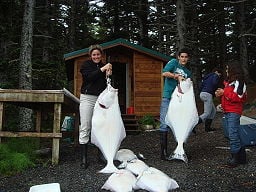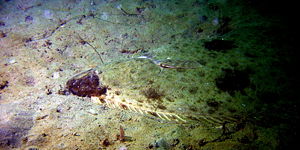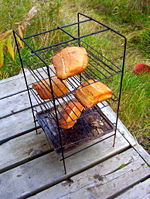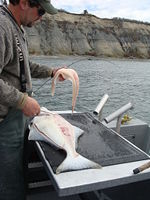Halibut
| Halibut | ||||||||||||
|---|---|---|---|---|---|---|---|---|---|---|---|---|
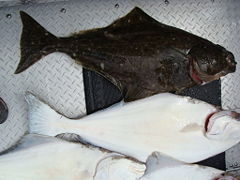 Pacific halibut (H. stenolepis).
Halibut tend to be a mottled brown on their upward-facing side and white on their downside | ||||||||||||
| Scientific classification | ||||||||||||
| ||||||||||||
|
H. hippoglossus (Atlantic halibut) |
Halibut is the common name for any flatfish (order Pleuronectiformes) belonging to the genus Hippoglossus from the family of right-eye flounders (Pleuronectidae), of which there are two extant species, the Atlantic halibut (H. hippoglossus) and the Pacific halibut (H. stenolepis). Demersal fish, that live near the bottom of the ocean as adults, halibut are characterized by having both eyes on their dark or upper side and somewhat more elongated bodies than other flatfish, with a somewhat lunate caudal fin. They also exhibit large size, being among the largest teleost (bony) fish in the world. They also are strong swimmers and can migrate long distances. The common name halibut also is used for some other species of flatfish.
The Atlantic halibut is native to the temperate waters of the northern Atlantic, from Labrador and Greenland to Iceland, the Barents Sea and as far south as the Bay of Biscay. The Pacific halibut is found on the continental shelf of the North Pacific Ocean and Bering sea.
Halibut is a very popular food, with lean, white, sweet-flavored flesh with few bones and high nutritional value. As a result, a lucrative halibut fishery has developed, and it is also popular in sport fishing. Halibut also is important ecologically as an integral part of marine food chains. An adult female can produce millions of eggs, with the eggs and larva providing food for numerous marine animals. And while the adult halibut is so large that it is near the top of the food chain, it too may be preyed upon by sea lions, orcas, sharks, and seals. On the other hand, the strong-swimming halibut is able to capture and feed upon a wide variety of fish, crustaceans, and mollusks.
Despite these ecological, commercial, recreational, and nutritional values, overfishing of the Atlantic halibut has resulted in being rated as an endangered species, with a high risk of extinction in the wild. A contributing factor is that the halibut does not reach sexual maturity until roughly eight years of age. The Pacific halibut, however, continues to have healthy populations, and remains a lucrative commercial fishery.
Overview and description
Halibut are a type of "flatfish." Flatfish are an order (Pleuronectiformes) of ray-finned fish (Actinopterygii,). (Flatfish sometimes are classified as a suborder of the order Perciformes.) Flatfish are a very distinctive group in that the adults are not bilaterally symmetrical, the only fish with such asymmetry and the only vertebrates that deviate so radially from the bilaterally symmetrical body plan (Grzimek et al. 2004). The young flatfish are bilaterally symmetrical and swim upright as with other fish, but early in development one of the eyes migrates to the other side of the cranium, across the top of the skull, and positions itself adjacent to the eye on the other side (Nelson 1994). The fish then swims with the two eyes on the upper side and lower side is blind. The metamorphosis also involves the upper side generally pigmented and the lower side light colored, and changes in dentition and fin placement.
Most species face either their "left" side upward (both eyes on the left side and lie on the right side) or else face their "right" side upward. Another distinguishing feature of the order is the extension of the dorsal fin onto the head. The body is highly compressed and somewhat flat on the blind side and rounded on the eyed side (Nelson 2006). Adults are almost always lacking a swim bladder (Nelson 2006).
Halibut belong to the family of flatfish that face their "right" side upward, the righteye flounder, family Pleuronectidae. As with other righteye founders, the halibut have a lateral line that is well developed on both sides and symmetrical pelvic fins (Nelson 2006). Nelson (2006) placed the halibut, genus Hippoglossus within the subfamily Hipoglossinae, along with the genera Atheresthes, Clidoderma, Reinhardtius, and Verasper. Halibut in general are a more elongate fish than other flatfish, being only about one-third as broad (width of the body) as is long (Bigelow and Schroeder 1953). They have a relatively large, nearly symmetrical mouth, that extends to below the lower eye and small, smooth scales that are buried in the skin (IPHC 1998). The tail has been described as crescent-shaped, lunate, or concave.
The Atlantic halibut, Hippoglossus hippoglossus, is the largest flatfish in the Atlantic and one of the largest species of teleost fish in the world. Luna and Torres (2010) report a maximum length of 4.7 meters (15 feet) and a maximum published weight of 320 kilograms (710 pounds). The Atlantic halibut's upper surface (eyed side) is a uniformly dark brown, olive or black, though younger fish are lighter and more mottled or spotted with paler marks; the underside is pale, with the larger fish having an underside often blotched or clouded with gray (called "grays" by fisherman) and sometimes patches with the same color as the upper side, while the small fish having an underside that is pure white (Bigelow and Schroeder 1953). The end of the caudal fin is concave, not rounded. It lacks dorsal spines, but has about 98-110 dorsal soft rays, and 73-85 anal soft rays (Luna and Torres 2010). The anal fin begins shortly behind the pectorals; the small ventral fins are in front of the pectorals and separated from the anal fins by considerable space (Bigelow and Schroeder 1953). The Atlantic halibut has been reported to reach a maximum lifespan of 50 years (Luna and Torres 2010; Bigelow and Schroeder 1953).
The Pacific halibut, Hippoglossus stenolepis, is one of the largest teleost fish in the Pacific, with the largest sport caught halibut being 459 pounds (208 kg) near Unalaska, AK, in 1996 (Bethers 2010). Luna and Pablico (2010) report a maximum length of 2.58 meters (8.5 feet) and a maximum published weight of 363 kilograms (800 pounds). The Pacific halibut are characterized by diamond-shaped bodies. There is a high arch in the lateral line over the pectoral fin, and it has a lunate, or crescent shaped tail. The color on the dark side varies, but tends to assume the coloration of the ocean bottom. The underside is lighter. It lacks dorsal spines, but has about 90-106 dorsal soft rays, and 69-80 anal soft rays; the pectorals are small (Luna and Pablico 2010). The dorsal fin begins above the anterior part of the pupil in the upper eye (Luna and Pablico 2010). Luna and Pablico (2010) note that the Pacific halibut has been reported to reach a maximum age of 42 years; however, other reports for the Pacific halibut has the oldest recorded specimen for a male being 55 years old and the oldest age for a female being 42 years old, based on otolith (ear bone) measurements (IPHC 1998).
The two species were first distinguished by a Russian scientist in 1904, who differentiated the Pacific and Atlantic counterparts on the basis of such anatomical differences as the length of the pectoral fin, the shape of the body,and the shape of the scales. However, it has been debated whether or not the two actually are separate species (IPHC 1998).
Although halibut size is age and sex specific , it also follows a cycle that has been related to halibut abundance. The average fish size seems to reflect density dependence in growth rate, where slower growth is associated with higher halibut (or other species) abundance, potentially due to less food available per fish.
Distribution and habitat
The Atlantic halibut is found in temperate waters of the Eastern and Western Atlantic. In the Eastern Atlantic, it is found from the Bay of Biscay to Iceland, eastern Greenland, Spitsbergen (island of the Svalbard archipelago in Norway), and Barents Sea (Luna and Torres 2010). In the Western Atlantic, it is found from southwestern Greenland and Labrador in Canada to the U.S. state of Virginia (Luna and Torres 2010). They are demersal fish, that live on or near sand, gravel or clay bottoms at depths of between 50 and 2000 meters. They are strong simmers and able to migrate long distances.
The Pacific halibut is found on the continental shelf of the North Pacific Ocean and Bering sea. In the North Pacific, they are found from Hokkaido, Japan and the Sea of Okhotsk to the southern Chukchi Sea and Point Camalu, Baja California, Mexico (Luna and Pablico 2010). The Chukchi Sea is a marginal sea of the Arctic Ocean, bounded on west by the De Long Strait, off Wrangel Island, and in the east by Point Barrow, Alaska, with the Bering Strait forming its southernmost limit. Demersal fish, the adults live on or near the bottom of the water and prefer water temperatures ranging from 3 to 8 degrees Celsius (37.4 to 46.4 degrees Fahrenheit). Strong swimmers, they are able to migrate long distances. Halibut of all ages and sizes are involved in a predominantly clockwise (Northwest to Southeast) migration from their settlement areas (Western part of the Gulf of Alaska and Bering Sea). The adult fish tend to remain on the same grounds from year to year, but make regular, seasonal migrations to the shallower feeding grounds in summer and deeper spawning grounds in winter (IPHC 1998). From November to March, mature halibut concentrate annually on spawning grounds along the edge of the continental shelf at depths from 183 to 457 meters (600 to 1,499 feet).
Pacific halibut life cycle
In the Pacific halibut, spawning takes place during the winter months with the peak of activity occurring from December through February. Most spawning takes place off the edge of the continental shelf in deep waters of 600 to 1,500 feet (183 to 457 meters). Male halibut become sexually mature at 7 or 8 years of age while females attain sexual maturity at 8 to 12 years. Females lay half a million to four million eggs annually, depending on the size of the fish (IPHC 1998).
Externally fertilized in the deep water, the eggs are free-floating and about 3 mm in diameter when released. The eggs hatch after about 15 to 20 days. The eggs develop into larva and grow, slowly drifting upward in the water. The free-floating larvae float for up to six months and can be transported several hundred miles counter-clockwise by North Pacific currents. During the free-floating stage, many changes take place in the young halibut, including the movement of the left eye to the right side of the fish. During this time the young halibut rise to the surface and are carried to shallower water by prevailing currents. At six months, the halibut has its adult form and is about 1.4 inches (3.6 cm) long. In the shallower water, young halibut then begin life as bottom dwellers. Most young halibut ultimately spend from five to seven years in rich, shallow nursery grounds like the Bering Sea (IPHC 1998).
Young halibut are highly migratory and generally migrate in a clockwise direction east and south throughout the Gulf of Alaska. This clockwise migration of the young halibut counters the counter-clockwise drift of the eggs and larva. Halibut in older age classes tend to be less migratory but continue to move predominately in a clockwise direction. Mature fish are also involved in winter spawning migrations towards deeper waters migrating across several areas in some instances (IPHC 1998). Research indicated that there may be small, localized spawning populations in deep waters such as in Chatham Straight in northern Southeast Alaska. However, because of the free-floating nature of larvae and subsequent mixing of juvenile halibut from throughout the Gulf of Alaska, there is only one known genetic stock of halibut in the northern pacific.
Ecology
Diet
Halibut feed on almost any animal they can fit into their mouths and being strong swimmers, they are able to capture a large variety of fishes. Animals found in their stomachs include the octopus, crab, shrimp, hermit crab, lamprey, eel, sculpin, cod, pollock, flounder, and other halibut. Although halibut spend most of their time near the bottom of the ocean, they may move up in the water column to feed, capturing such pelagic fish as salmon, sand lance, and herring. Juvenile halibut feed on small crustaceans and other bottom-dwelling organisms.
Predators
While the young halibut serves as a food source for many animals, in most ecosystems, the adult halibut is near the top of the marine food chain. In the North Pacific, the adult Pacific halibut is preyed upon by the sea lion (Eumetopias jubatus), the orca (Orcinus orca), and the salmon shark (Lamna ditropis). Atlantic halibut are eaten by seals, and are a staple food of the Greenland shark.
Use as food by humans
Halibut is a very popular food. The name halibut itself means "holy flafish," derived from haly (holy) and butt (flat fish), for its popularity on Catholic holy days in England (Uncle Ray 1941). Historically, halibut also have been an important food source to Native Americans and Canadian First Nations and continue to be a key element to many coastal subsistence economies.
A lean fish, with white flesh that has few bones, and a high nutritional value, the halibut is a favorite among those who eat fish. Halibut are often broiled, deep-fried or grilled while fresh. Smoking is more difficult with halibut meat than it is with salmon, due to its ultra-low fat content. Eaten fresh, the meat has a clean taste and requires little seasoning. Halibut is noted for its dense and firm texture.
The Atlantic population is so depleted through overfishing that consumers are now cautioned to avoid Atlantic halibut. Most halibut eaten on the East coast of the United States are now from the Pacific, which has much healthier populations, and listed on the Monteray Bay Aquarium's Seafood Watch as the "best choice" as an alternative (MBA 2011).
Halibut fishery
The North Pacific commercial halibut fishery dates to the late 19th century and today is one of the region's largest and most lucrative. In Canadian and U.S. waters, longline predominates, using chunks of octopus ("devilfish") or other bait on circle hooks attached at regular intervals to a weighted line that can extend for several miles across the bottom. The fishing vessel retrieves the line after several hours to a day. The effects of longline gear on habitats are poorly understood but could include disturbance of sediments, benthic structures, and other structures. The halibut are cleaned soon after being boated and are kept on ice to retain freshness.
International management of the Pacific halibut fishery is necessary, because the species occupies waters of the United States, Canada, Russia, and possibly Japan (where the species is known to the Japanese as Ohyo), and matures slowly. Halibut do not reproduce until age eight, when about 30 inches long, so commercial capture below this length prevents breeding and is against U.S. and Canadian regulations supporting sustainability. Pacific halibut fishing is managed by the International Pacific Halibut Commission (IPHC). Fishing for the Pacific halibut is mostly concentrated in the Gulf of Alaska and the Bering Sea, off the West coast of Canada. Small halibut catches are reported in coastal Washington, Oregon, and California.
For most of the modern era, halibut fishery operated as a derby. Regulators declared time slots when fishing was open (typically 24â48 hours at a time) and fisherman raced to catch as many pounds as they could within that interval. This approach accommodated unlimited participation in the fishery, while allowing regulators to control the quantity of fish caught annually by controlling the number and timing of openings. The approach led to unsafe fishing as openings were necessarily set before the weather was known, forcing fisherman to leave port regardless of the weather. The approach limited fresh halibut to the markets to several weeks per year, when the gluts would push down the price received by fishermen.
The Atlantic halibut was formerly a very important food fish, but due to its slow rate of population growth it is unable to recover quickly from overfishing, and the fishery has largely collapsed. Consequently, fish labelled as "halibut" is usually one of the other large flatfishes, often the Pacific halibut.
Sport fishing
Sport fishing for halibut in Alaska is a very popular activity; it is a strong fighter and one of the worldâs largest bony fish with an impressive yield and firm, white flesh (Schultz 2010). Over 65 percent of the effort and harvest occurs in Kachemak Bay, Southeast Alaska, the Kodiak area, and near the mouth of Deep Creek in the Lower Cook Inlet.
Most anglers prefer to fish with bait, especially herring but also squid, octopus, cod pieces, or other small bottom fish, as well as herring and whole salmon heads. To get the bait down to the halibut, it is usually fished on a wire spreader or a sliding-sinker rig (Schultz 2010). Halibut are strong and fight strenuously when exposed to air. Smaller fish will usually be pulled on board with a gaff and may be clubbed or even punched in the head in order to prevent them from thrashing around on the deck. In both commercial and sport fisheries, it is not uncommon to shoot or otherwise subdue very large halibut before landing them. Alaska's sport fishery is an element of the state's tourism economy. Sportsmenâs effort and interest in catching these fish is increasing each year. In Southeast Alaska, halibut are second only to king salmon in sport angler preference (Bethers 2010).
Conservation status
Following overfishing the Atlantic halibut now faces a high risk of extinction in the wild, and in 1996 the IUCN rated it as Endangered and placed it on its Red List (Sobel 1996).
The Atlantic halibut is a U.S. National Marine Fisheries Service "Species of Concern." Species of Concern are those species about which the U.S. governmentâs National Oceanic and Atmospheric Administration, National Marine Fisheries Service, has some concerns regarding status and threats, but for which insufficient information is available to indicate a need to list the species under the U.S. Endangered Species Act (ESA). The American Fisheries Society has classified the species as "Vulnerable."
In 2010, Greenpeace International added the Atlantic halibut to its seafood red list. "The Greenpeace International seafood red list is a list of fish that are commonly sold in supermarkets around the world, and which have a very high risk of being sourced from unsustainable fisheries.
Species of the genus Hippoglossus (proper halibut)
- Atlantic halibut, Hippoglossus hippoglossus
- Pacific halibut, Hippoglossus stenolepis
Other species sometimes called "halibut"
- Of the same family (Pleuronectidae) as proper halibut
- Kamchatka flounder, Atheresthes evermanni - sometimes called "Arrowtooth halibut"
- Roundnose flounder, Eopsetta grigorjewi - often called "Shotted halibut"
- Greenland turbot, Reinhardtius hippoglossoides - often called "Greenland halibut"
- Spotted halibut, Verasper variegatus
- Family Paralichthyidae
- California flounder, Paralichthys californicus - sometimes called "California halibut"
- Olive flounder, Paralichthys olivaceus - sometimes called "Bastard halibut"
- Family Psettodidae
- Indian spiny turbot - sometimes called "Indian halibut"
- Family Carangidae (jack family, not a flatfish)
- Black pomfret, Parastromateus niger - sometimes called "Australian halibut"
ReferencesISBN links support NWE through referral fees
- Bigelow, H. B., and W. C. Schroeder. 1953. Atlantic halibut Hippoglossus hippoglossus (Linnaeus) 1758. Fishery Bulletin of the Fish and Wildlife Service 53(74): 249. Retrieved July 20, 2011.
- Clover, C. 2004. The End of the Line: How Overfishing is Changing the World and What We Eat. London: Ebury Press. ISBN 0091897807.
- Grzimek, B., D. G. Kleiman, V. Geist, and M. C. McDade. Grzimek's Animal Life Encyclopedia. Detroit: Thomson-Gale, 2004. ISBN 0307394913.
- International Pacific Halibut Commission (IPHC). 1998. The Pacific Halibut: Biology, fishery, and management. IPCH Technical Report No. 40. Seattle, WA: The International Pacific Halibut Commission. Retrieved July 20, 2011.
- Luna, S. M., and A. G. Torres. 2010. "Hippoglossus hippoglossus (Linnaeus, 1758), Atlantic halibut." In R. Froese and D. Pauly, Fishbase.org. Retrieved July 20, 2011.
- Monteray Bay Aquarium (MBA). 2011. Seafood Watch: Atlantic halibut. Seafood Watch.
- Nelson, J. S. 2006. Fishes of the World, 4th edition. Hoboken, NJ: John Wiley & Sons. ISBN 0471250317.
- Schultz, K. 2010. Ken Scultzâs Essentials of Fishing. Hoboken, NJ: John Wiley and & Sons. ISBN 9780470444313.
- Sobel, J. 1996. Hippoglossus hippoglossus. In IUCN Red List of Threatened Species Version 2011.1. Retrieved on July 20, 2011.
- Uncle Ray. 1941. [http://news.google.com/newspapers?id=OVIbAAAAIBAJ&sjid=c0wEAAAAIBAJ&pg=4454,336523&dq=halibut+popular+food-fish&hl=en Right eye of halibut moves over to the left side of head. The Pittsburgh Press September 10, 1941. Retrieved July 20, 2011.
Credits
New World Encyclopedia writers and editors rewrote and completed the Wikipedia article in accordance with New World Encyclopedia standards. This article abides by terms of the Creative Commons CC-by-sa 3.0 License (CC-by-sa), which may be used and disseminated with proper attribution. Credit is due under the terms of this license that can reference both the New World Encyclopedia contributors and the selfless volunteer contributors of the Wikimedia Foundation. To cite this article click here for a list of acceptable citing formats.The history of earlier contributions by wikipedians is accessible to researchers here:
The history of this article since it was imported to New World Encyclopedia:
Note: Some restrictions may apply to use of individual images which are separately licensed.
